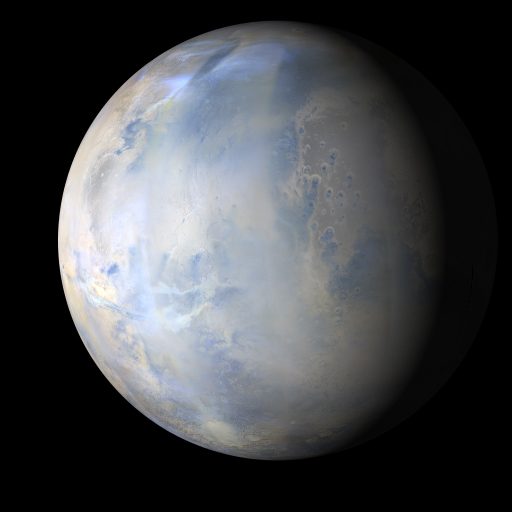
MRO MARCI Weather Report for the week of
|
 CLICK to play Quicktime Movie (5.3 MB) NASA/JPL/Malin Space Science Systems |
Martian Weather Between 10 and 16 December 2007:
The Mars Reconnaissance Orbiter (MRO) Mars Color Imager (MARCI) camera resumed collecting new data late on Wednesday, 12 December. The first full global map was obtained the next day. Please click and play the Quicktime movie (.mov file) to see how the weather on Mars changed during the last half of last week.
Spring has arrived to the Martian northern hemisphere. Local dust storms continued to be observed along the receding northern seasonal cap edge and at southern mid-latitudes. With the storms presently isolated poleward of 45° latitude, the relatively cool afternoon atmospheric temperatures in the tropics are ideal for the development of water-ice clouds, which could be seen all across the planet, from Elysium and Cimmeria in the east to Tempe and Acidalia in the west, as well as the usual location over the Olympus and Tharsis volcanoes.
Storm-free skies are goods news for the Mars Exploration Rovers (MERs) in Gusev Crater and Meridiani, which survived a planet-encircling dust event earlier in the year and are just about to bed down for a long winter's rest.
Earlier Mars Weather Reports are available HERE.
About the Quicktime Movie:
The movie (a .mov file that you can click and play, above)
was generated from images obtained by the Mars Color Imager (MARCI) onboard the
Mars Reconnaissance Orbiter (MRO). During a nominal operational week, a total
of about 273 MARCI images, taken in three of the camera’s seven color filter
bands (420, 550, and 600 nanometer wavelengths), are map projected and mosaiced together to produce seven false-color daily
global maps. These maps are then projected onto a sphere with north at the top and east to the right and
with the mid-afternoon vantage point of an observer in the orbital plane (the imaginary plane that the planet
draws out as it circles the Sun).
Black areas in the movie are the result of data drops or high angle roll maneuvers by the spacecraft that limit
the camera’s view of the planet. Equally-spaced blurry areas that run from south-to-north (bottom-to-top) result
from the high off-nadir viewing geometry, a product of the spacecraft’s low-orbit, 250 km x 316 km (155 miles x 196 miles).
The movie is rendered at a lower resolution than the intrinsic 1–2 km nadir resolution that the MARCI provides, so that it
is practical to view and share via the Internet. The small white circles on these images of Mars indicate the
locations of the two Mars Exploration Rovers, Opportunity (on Meridiani Planum) and Spirit (in Gusev Crater). Other locations
on Mars referenced in the weather report can be found by referring to the map below. Note that the still image of Mars depicted
at the top of this page is a single frame from the Quicktime movie.
|
Reference Map — Martian Place Names Commonly Mentioned in Mars Weather Reports
NASA/JPL/Malin Space Science Systems |
Citation and Credit
The image(s) and caption are value-added products. MSSS personnel processed the images
and wrote the caption information. While the image(s) are in the Public Domain,
NASA/JPL/MSSS requests that you credit the source of the image(s). Re-use of the
caption text without credit is plagiarism.
Please give the proper credit for use of the image(s) and/or caption.
Image Credit:
NASA/JPL/Malin Space Science Systems
—or—
NASA/JPL/MSSS
To cite the image(s) and caption information in a paper or report:
Malin, M. C., B. A. Cantor, and J. A. Lougen (2007), MRO MARCI Weather Report for the week of
10 December 2007 – 16 December 2007,
Malin Space Science Systems Captioned Image Release, MSSS-7,
http://www.msss.com/msss_images/2007/12/18/.
Malin Space Science Systems (MSSS) built and operates the Mars Reconnaissance Orbiter (MRO) Mars Color Imager (MARCI) and Context Camera (CTX). MSSS also built and operated the Mars Global Surveyor (MGS) Mars Orbiter Camera (MOC). In addition, MSSS built the Mars Odyssey (ODY) Thermal Emission Imaging Spectrometer (THEMIS) Visible (VIS) camera subsystem, which shares optics with the thermal infrared instrument and is operated at Arizona State University (ASU). MSSS also built the Mars Descent Imager (MARDI) cameras for the Mars Polar Lander and Phoenix Mars lander missions, and the MARCI onboard the Mars Climate Orbiter. Currently, the company is building cameras for the 2008 Lunar Reconnaissance Orbiter, 2009 Mars Science Laboratory rover and the 2011 Juno mission to Jupiter.
 Malin Space Science Systems, Inc., San Diego, California, U.S.A.
Malin Space Science Systems, Inc., San Diego, California, U.S.A.